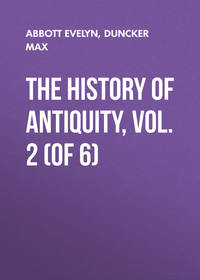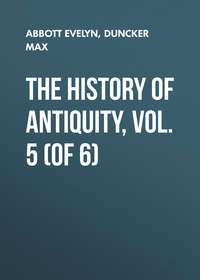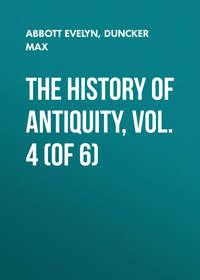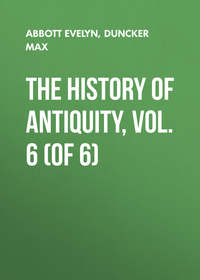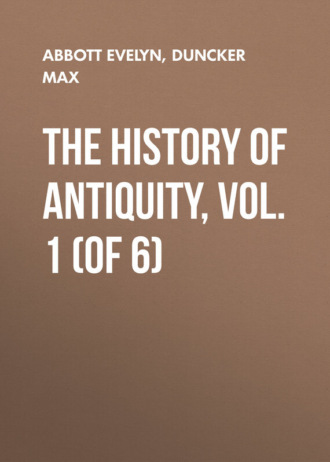 полная версия
полная версияThe History of Antiquity, Vol. 1 (of 6)
A nation of heroines was certainly never found by the Greeks on the Thermodon. On the other hand, they received accounts of the warlike queens of the Saces and Massagetæ, of Zarinæa, Sparethra, and Tomyris, who fought against the Medes and Persians; and on the coasts of the Black Sea, in the colonies of the Milesians, they heard of the riding, the archery, and hunting of the women of the Sauromatæ. Hence the Greeks resolved to make the Amazons the ancestors of the Sarmatians. They were represented as taking ship from the Thermodon across the Black Sea to the coast of the Mæotis, because here, in the Crimea, on the "promontory of the maiden," a cruel maiden goddess, who was also called Artemis Tauropolus by the Greeks, was worshipped. Herodotus, and after him Ephorus, tells us that the Amazons fled over the Pontus from the Thermodon, and landed on the shore of the Mæotis. Here they took the young men among the Scythians, who, according to Herodotus, were settled between the mouths of the Danube and the Don, as their husbands, and with them marched eastwards over the Tanais (Don), beyond which river and north of the Caucasus lay, according to Herodotus, the dwellings of the Sauromatæ, whom later writers call the Sarmatians. Hence the Sarmatian women still preserved the customs of the Amazons; they carried bows and javelins, and wore the same clothing as the men, sat on horseback, and rode with or without their husbands to the chase or to battle, and no maiden married till she had slain an enemy; "so that some never married at all, because they were unable to satisfy this rule." The language of the Sauromatæ was the same as the language of the Scythians, but they spoke it badly, because the Amazons had never perfectly learned it. These statements, and especially the assertion that the Sarmatian women fought as long as they were maidens, were repeated by Greek writers – in other respects very trustworthy – in the fifth and fourth century B.C. Others also maintained that the women were rulers among the Sarmatians.799 Poetry and plastic art had stamped the legend of the Amazons so firmly on the Greeks that they could not break loose from it. Several of the historians of Alexander of Macedon tell us that the queen Thalestris, with 300 Amazons, sought out Alexander from a great distance, and made a proposal of marriage to him, on his return from Hyrcania,800 a story which has perhaps arisen out of the fact that the satrap Atropates of Media sent 100 mounted women to Alexander.801 When at a later time Pompey fought in the Caucasus, and women were found among the wounded, it was thought that the real Amazons were at last found;802 and the story was now told that the Amazons dwelt northward of the Gelen (in Ghilan), on the southern foot of the Caucasus. In order to solve the difficulty of their propagation of the race, the story was invented that for two months in the spring they met the Gargareans – a neighbouring tribe – on the mountains by night, and associated with them, as accident might determine. The boys were then sent to the Gargareans, who brought them up in common; the daughters were retained by the Amazons.803 In order to explain the name Amazon, which in Greek can mean "without a breast," the story was invented that they burnt off the right breast of the maidens, so that they might use the right arm better, and draw the bow – a story which Hippocrates had already told about the daughters of the Sarmatians.804 On the monuments of plastic art the Amazons have both breasts; the older period represents them with a broad girdle, an ample robe, and a Phrygian cap, a crescent shield (the symbol of the moon-goddess), a bow, and a battle-axe. In later sculptures the Amazons, when they had been connected with the Scythians and the Sarmatians, were generally represented on horseback, in a Doric tunic, with naked arms and thighs, a helmet on the head, and a spear in the hand.
On the western slopes of the table-land of Asia Minor, in the river valleys of the Hermus and Mæander, the Lydians were settled. Their land reached from the sources of the Hermus in Mount Dindymon to the Ægean sea, from Messogis and Cadmus in the south to the Temnus range in the north. The valley of the Hermus was exuberantly fertile, and still more luxuriant was the vegetation in the district round the Gygæan lake. The mountain pastures supported herds of powerful horses and numerous flocks of sheep. The Pactolus brought sands of gold down from Tmolus; in the rocks of this range and its western continuation, Sipylus, rich veins of gold are said to have been found.805
But little has been preserved of the legendary accounts of the Lydians about their rulers in the earliest times. About the middle of the fifth century B.C. the Lydian Xanthus, the son of Candaules, wrote the history of his people in four books, in the Greek language. Of this some fragments have come down to us, which can here and there be supplemented by the statements of Herodotus. From both we learn that the Lydians traced back the origin of their royal house to the gods. Atys, the son of the god Manes, was the first sovereign of the Lydians; after him came his son Lydus, who gave the name to the people. From the brother of Lydus, whom Xanthus calls Torrhebus, and Herodotus Tyrsenus, the tribe of the Torrhebians or Tyrsenians was derived. The territory of the Torrhebi lay on the upper Cayster. From Asius, the son of Cotys, the son of Atys, sprang the tribe of the Asionæans, who inhabited the Asian meadow.806 From Atys, their progenitor, the first king, his successors, the first house of Lydian kings, were called Atyads. Among the successors of Lydus the most pious and just was Alkimus. During his reign there was peace and quiet in Lydia; every man lived securely and without fear, and all things prospered. After him reigned king Akiamus, who sent Ascalus with an army to Syria. There Ascalus founded the city of Ascalon. After this, as Herodotus narrates, a lion was born to king Meles from his concubine, and this lion, in obedience to an oracle, he caused to be carried round the walls of Sardis, his metropolis, in order that they might be impregnable.807 According to Xanthus, Meles, who was a tyrannous and cruel king, was overthrown by Moxus, a very just and brave man, after he had vowed to the gods that, in gratitude for their deliverance, the Lydians should henceforth offer to them a tenth of all their animals. Then Moxus marched to Syria, and there took Atargatis captive, with her son Ichthys (fish). As a punishment for her rebellion she was thrown into the lake of Ascalon, and eaten by the fish. Then king Cambletes reigned, who sacrificed his wife, and ate her, and then slew himself with his sword before all the people. After him Jardanus, who had been an enemy of Cambletes, ruled over Lydia.808 Jardanus was followed by his daughter Omphale.809 To avenge the insult which had been paid to her before she ascended the throne of Lydia, she compelled the maidens of the land to give themselves up to the slaves at an appointed place, and slew the strangers whom she entertained, when she had lain with them.810 After Omphale, Tylon reigned, who died from the bite of a snake, but was again restored to life by a marvellous herb.811 But with the slave-girl of Jardanus, according to Herodotus, or, according to others, with Omphale, Heracles begot Alcæus; the son of Alcæus was Belus; the son of Belus was Ninus, and the son of Ninus was Agron. With the accession of Agron the dominion of the Atyads came to an end, and that of the Heracleids commenced, who then continued to rule over Lydia for 505 years.812
Manes and Atys are already known to us as deities of the Phrygians; they must therefore have been worshipped by the Lydians also. Lydus, the second king of the land, is taken from the name of the nation. The prosperous, peaceful reign of the good king Alkimus is no doubt founded on some conception of an early happy age. The story of the lion of Meles obviously goes back to the relations in which the lion was placed, in the religious rites of the Syrians, to the sun-god, who was also worshipped with zeal by the Lydians. We learn from a Lydian that the name Sardis was given to the city in honour of the sun-god.813 The coins of Sardis which have been preserved regularly present the image of a lion and a bull.814 The vow of Moxus is intended to explain the blood-tithe, which we have already found in use among the tribes of Syria. Still more definite are the references to Syrian rites in the supposed marches of Moxus and Ascalus to Syria, and the prominent position of Atargatis815 and the temple of Ascalon, and the children of Atargatis, the fish. We know Atargatis, the Astarte of the Assyrians, as transformed into Hera, and the temple at Ascalon, the city of the Philistines, as the oldest and most famous sanctuary of the Syrian goddess of fertility. The name of the king Jardanus does not differ from "jarden" (river), and if Omphale is said to have forced the maidens of the land to prostitute themselves at a fixed place, we have already found this prostitution in the worship of the Syrian goddess of birth and the Babylonian Mylitta. The new dynasty which ascends the throne of Lydia after the Atyads with Agron is again derived from a god, according to the accounts of the Greeks, from Heracles and Omphale. The Greeks narrated that Omphale carried the lion's skin and club of Heracles, and that she clothed the hero in a transparent female robe of scarlet, and caused him to card wool and spin as her slave.816 Lydian coins exhibit a female form with the lion's skin and the bow.817 It was shown above that the Greeks connected Melkarth (Melicertes) with their Heracles, and that according to the mythus of the Syrians, the sun-god finds and overpowers the moon-goddess; that after the holy marriage, the god on his part succumbs to the goddess, and changes his nature with her; he assumes the female nature, she the male; she carries the weapons, while he performs woman's work. We saw that the Syrians symbolised the pre-eminent nature, the unity of the deity, in this amalgamation of the sexes – this female manhood and male womanhood. Johannes Lydus tells us that the Lydians worshipped the sun-god under the name Sandon, and adds, that because Sandon had lived as a woman, the men at the mysteries of the god clothed themselves in women's clothes, and put on transparent crimson garments, coloured with vermilion.818 Thus the Greeks put their hero in the place of the Lydian sun-god, who overwhelms the lion, and changes his nature with the goddess; and if they farther tell us that Omphale gave her love to strangers, but also slew all who lay with her, this also is a trait which had already met us in the Syrian Astarte, in the nature of Ashera-Astarte, which at one time grants the enjoyment of love, and at another brings destruction.
The result of these considerations proves that the traits of the Lydian legends, which have been preserved, present us with very little beyond mere mythical elements. The connection of the Lydian worship with the worship of the Syrians comes plainly to the surface, and this connection is confirmed by all that we know from other sources of the rites of the Lydians. The name of their sun-god Sandon819 recurs on Assyrian monuments, where it appears as Sandan.820 In the Semitic languages the word means "helper," and is used as an attribute of the god Adar, with whom we are already acquainted as the god of the planet Saturn.821 It is obvious that the title "helper" could be given not to Adar only, but to any other god, from whom special favour and assistance might be expected. The Lydians gave the title to the good sun-god, who vanquishes the glowing heat – the terrible sun-god – who looses the girdle of the moon-goddess, and changes his nature with her. When the Greek colonists landed on the coast of Lydia, they at first recognised their own Apollo, i.e. their god of light, in the Lydian god. They allowed the sanctuary of the Lydian god at Miletus to remain in the hands of a family of native priests, the Branchidæ. As god of the country and protector of the coast, the Homeric poems give to Apollo the foremost place among the deities who defend Troy. The Lydians also on their side recognised the connection between their sun-god and the Apollo of the Greeks; Gyges and Crœsus send rich presents to Delphi. But when the Greeks of the coast became more accurately acquainted with the nature and the myths of the Lydian sun-god, that side which chiefly corresponded to their Heracles, and the image of Heracles developed under the influence of the Phenician Melkarth, came into prominence. The nature of the female goddess also, whom the Lydians chiefly worshipped, is beyond doubt. Herodotus tells us that all the daughters of the Lydians sold themselves, and in this way collected their dowries; others narrate that they received slaves or foreigners in the groves and porticoes of the temples.822 As we have seen, tradition connects this prostitution with the rule of Omphale, and Johannes Lydus assures us that the goddess Blatta worshipped in Lydia was the same as the Mylitta of the Babylonians. Hence the worship of Bilit, the Ashera of the Syrians, prevailed also among the Lydians, a fact which the campaigns (already mentioned) of Ascalus and Moxus to the shrine of Derceto at Ascalon also prove. That this goddess of the Lydians was not without her destructive side – the power and nature of Astarte – we could already infer from the bloody acts of Omphale (p. 562). At the mouths of the Cayster and the Hermus the Greeks found the shrines of a goddess, whose priests were eunuchs, and who was at the same time honoured with dances in armour by maidens, as the moon and war-goddess of the Cappadocians.823 This goddess of the coasts of Lydia was called by the Greeks Artemis, and this name distinguishes her as at once a maiden goddess and the goddess of the moon and of war. And if at the same time the image of Artemis of Ephesus was represented with large breasts, the obvious conclusion is that in the goddess of Lydia, as in the goddesses of Babylonia and Syria, the two opposites, of continence and sensual enjoyment, of fertility and of destruction, were united.
The forms of religious worship also would appear to have been in all essentials the same among the Lydians and the Syrians. Mutilation (which we know was practised very widely among the Lydians),824 and the prostitution of girls, were common to both countries. We found above that the Arabs and Syrians believed their gods to be present in stones, and prayed to them in that shape. Not far from Magnesia on Sipylus, a stone, some twenty feet in height, juts out of a wall of marble, and this in ancient times must have been regarded with veneration as the idol of a native goddess. Even in the Homeric poems we find mention of this stone, and the legend connected with it by the Greek colonists. "I have seen the stone of Niobe on Sipylus," said Pausanias. "At a near view it is a fragment of stone, which does not look like a woman or a person weeping; but from a distance you might believe that you saw a weeping and mourning woman."825
The essential result of the examination of Lydian legend and Lydian worship is the obvious and very close relationship between the Lydian and Syrian deities and rites. Moreover, the mountain range which bounds the valley of the Mæander to the south, bears the Semitic name of Cadmus, i. e. "the Eastern;" and at the foot of the range lies the city of Ninoë (Nineveh, i. e. "to dwell.")826 Again, from one side the languages of the Phrygians and Lydians are said to be distinctly different; on the other hand, most of the Lydian words which have been preserved to us by the Greeks – it is true they are not numerous – can be traced back to Semitic roots;827 and the national genealogy of the Hebrews enumerates Lud among the sons of Shem, together with Elam, Asshur, Arphaxad, and Aram. Yet, so far as the Lydian language allows us to form an opinion, elements of a different character are not entirely wanting. The gods Manes and Atys, from whom the first royal house was derived, and after whom it was named, the goddess Cybele, whose temple stood at Sardis,828 do not belong to the circle of Semitic deities. Manes, as well as Atys, we found in Phrygia. Hence, looking back at the connection between the Armenians, Phrygians, and Thracians, already brought into prominence we may suppose that the original population of the river valley of the Hermus was Phrygian, and that Semitic invaders from the east subjugated these Phrygians and absorbed them; but not without adopting on their part some elements of the Phrygian language and worship.
That a monarchy was in existence among the Lydians before the first Heracleid ascended the throne cannot be doubted. In the time of the Heracleids we find mention made of the descendants of Tylon (p. 562), a king who is said to have belonged to the family of the Atyads. The foundation and fortification of Sardis also seem to belong to the period before the Heracleids, the period of the Atyads. Herodotus tells us that the second dynasty, the supposed descendants of Sandon-Heracles, gave twenty-two sovereigns to the Lydians, who ruled over Lydia for 505 years.829 However astonishing the pedigree which Herodotus gives to these Heracleids (the son of Heracles, Alcæus, begets Belus, Belus begets Ninus, and Ninus Agron),830 we may regard his statement of the period for which this dynasty lasted, of which several later members are established, as historical. And since, after the Heracleids, the family of Gyges ruled for 140 years down to the time when Cyrus took Sardis, and since the taking of Sardis fell in the year 549 B.C., the Heracleids must have ascended the throne of Lydia 645 years previously, i. e. in the year 1194 B.C.831 What degree of civilisation had been reached by the Lydians about the year 1000 B.C. we can only conclude from the fact that the Greek settlers on their coasts found money already coined by the Lydians, and therefore ascribe to them the invention of the art of coining.832 The art of dying wool also was, in the opinion of the Greeks, an invention of the Lydians; and games at ball as well as at dice were thought to have been learnt from the Lydians by the Greeks.833 That the Greeks made use of the Lydian flute, and subsequently of the Lydian cithara (both the cithara with three strings and that with twenty strings), and the Lydian harmonies to enrich their own music, is an established fact.834 The Homeric poems describe the Lydians (Mæonians) as an "armed equestrian people," and mention their trade and wealth.835
North of the Lydians, in the river valleys of the Caïcus Macestus and Rhyndacus, were settled the Mysians. According to Strabo, they spoke a language of mixed Phrygian and Lydian elements.836 It was apparently the Mysian legend which told of king Tantalus, who possessed the greatest treasures, who slew his son and offered him for a banquet, i. e. for a sacrifice to the gods. His grave was shown on Sipylus.837 Before the Greek colonists took the coasts from them, the Mysians may have risen to the first elements of civilisation; but when they were debarred from the sea, they remained within the limits of their mountains, pursuing an agricultural and pastoral life. About the year 500 B.C. their armour was still a small round shield and javelins, the points of which were hardened in the fire.838 In spite of these miserable weapons they gave a good deal of trouble to the satraps of the Persian king, and even at a later time desolated the fruitful plains on the coasts by marauding inroads. Of their worship we only know that the Greeks found the rites of a god of light on the coasts at Thymbra, Chryse, and Cilla, who was invoked under the title Smintheus, a word which is said to mean the expeller or destroyer of field-mice;839 and that a goddess of procreation and fertility was worshipped on Ida.840 In the Homeric poems it is Aphrodite, by the side of Apollo, who protects Ilium, and favours Capys and the sons of Priam in the dells of Ida.
The coast of Asia Minor, to the south of the Lydians, was in the possession of the Carians. Herodotus tells us that, according to the legends of the Cretans, the Carians were, in the most ancient times, called Leleges, and inhabited the islands of the Ægean at the time when Minos reigned in Crete. They were compelled to man the fleet of Minos. A long time afterwards they were driven out of the islands by the Ionians and Dorians, and migrated to Asia Minor. But the Carians themselves maintained that they had always lived in the land which they possessed.841 We cannot hesitate to give the preference to the assertion of the Carians. From the numerous harbours of their coast they could easily cross to the neighbouring islands, and thus they could populate Rhodes Samos and Chios.842 Advancing from one to another in the numerous islands of this sea, they reached the Cyclades and settled there. The most ancient population of Crete, called by the Greeks Eteocretes, may very likely have consisted of Carians only, as is proved by the position which Greek legend gives to the Carians in reference to Minos, as well as by other evidence. This occupation of the islands of the Ægean Sea by the Carians must be placed about the year 1500 B.C. For when the Phenicians colonised these islands in the thirteenth century, they were occupied by Carians. The Carian population became dependent on the Phenicians. Subsequently, about the year 1000 B.C., the Hellenes landed on the islands of the Ægean, and drove out the Carians. The Carians lost even Samos and Chios; they were again confined to their old home, and they could not even maintain themselves in that, for the best harbours of their coasts passed into the hands of the Greeks. Yet the Carians continued to be seamen and pirates. They lay in wait, as before, for the merchants, and overran the rich coast land. Even in the seventh century we meet with Carian pirates and mercenaries, and these not only on the mouths and banks of the Nile; and the Chronographers mention, apparently, a hegemony of the Carians on the sea, which is placed in the interval from the year 731 to the year 670 B.C.843
The Carians had no monarchy embracing the whole of their territory. But here also, so far as we can see, princes stood at the head of the various cities. A kind of confederation united the several places. About the year 500 we hear of assemblies of Carians on the banks of the Marsyas near the white pillars, and afterwards we find common sacrifices of the Carian cities, and days of meeting in the temple of Zeus Chrysaor, which was situated in the neighbourhood of Mylasa (now Milas) at Lagina (now Leïna).844 Among the Carians the Greek colonists found a style of armour superior to their own, and they adopted it. The "Catalogue of ships," in Homer, represents the leader of the Carians as going into battle decked with gold.845 In Alcæus "the Carian helmet laments," and Anacreon speaks "of putting the hand upon the well-fitted Carian haft." Herodotus tells us that the Greeks learned from the Carians to wear plumes upon their helmets, to paint devices upon their shields, and to furnish them with fixed handles, – in Homer the shields are carried over the shoulder by straps. Greaves also are said to have been invented by the Carians.846
We are unable to tell with certainty the origin or the national characteristics of the Carians, though Herodotus maintains that the Lydians, Mysians, and Carians spoke the same language. Of the religious worship of the Carians he tells us that they were the only nation who worshipped Zeus as a warrior. Mylasa was the centre of their worship. On the heights which tower over the plain of Mylasa, in a forest of plane-trees, near Labranda, lay the temple of "Zeus Stratius." The image of the god is said to have carried the double axe. Carian coins of the fourth century B.C. display the image of a god with a double axe.847 The same axe is also found on the remains of Carian altars. The Greeks even maintain that the god was named after this axe, that his national name was Labrandeus, and that in Lydian and Carian labrys meant a battle-axe. Plutarch says: – Arselis, the Carian of Mylasa, marched to the aid of Candaules, king of Lydia (he ruled about the year 700 B.C.), and afterwards he left the sacred axe of the kings of Lydia to the god of Labranda.848 This giving up of the battle-axe to the god of the battle-axe allows us to suppose that the god of Mylasa is meant by the Carian of Mylasa; and that Arselis may have been the name or attribute of this god – a supposition which is changed into a certainty by the fact that in Semitic languages, Chars-el means "axe of El," "axe of God."849 Beside this warrior Zeus, a warlike Aphrodite was also worshipped at Mylasa,850 and if Strabo calls the goddess of Leïna Hecate, the reason of the name may be the death-bringing power of the goddess Astarte-Ashera. The sacred fish who were to be found in a pool at Mylasa, with gold rings round the neck, would then be evidence of the bountiful, increase-giving side of the nature of this goddess.851


